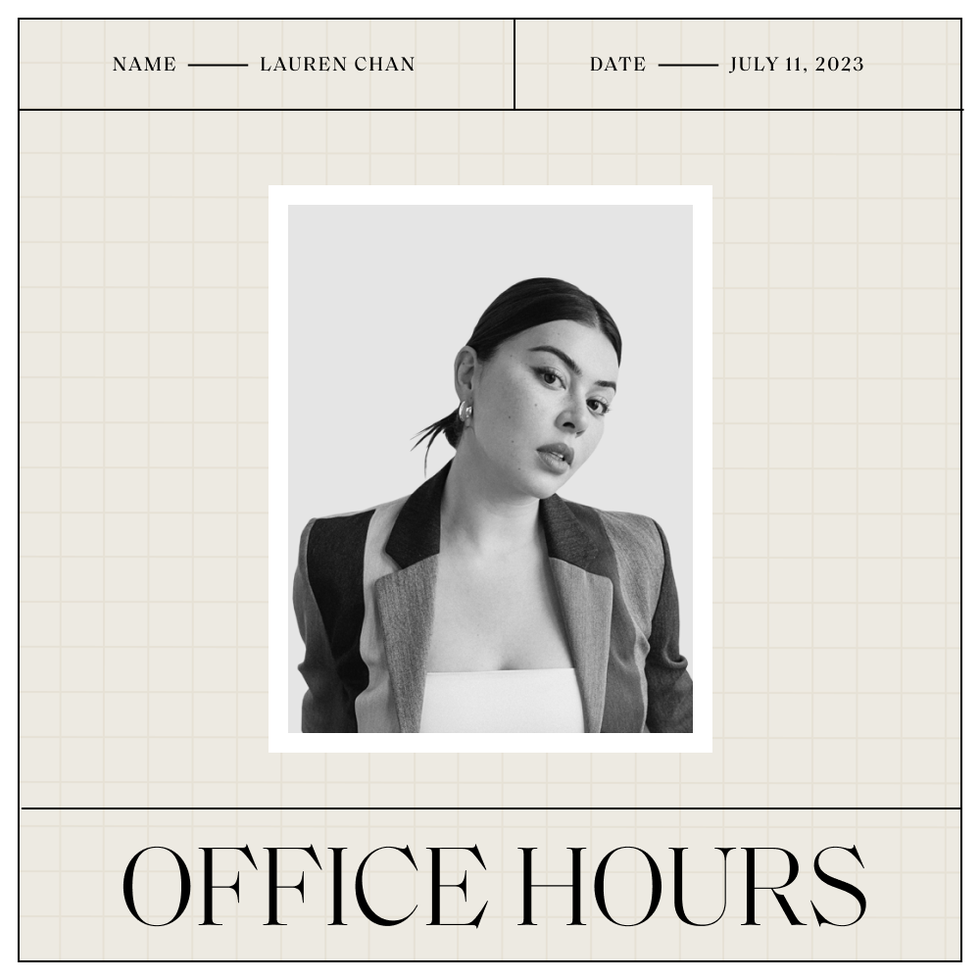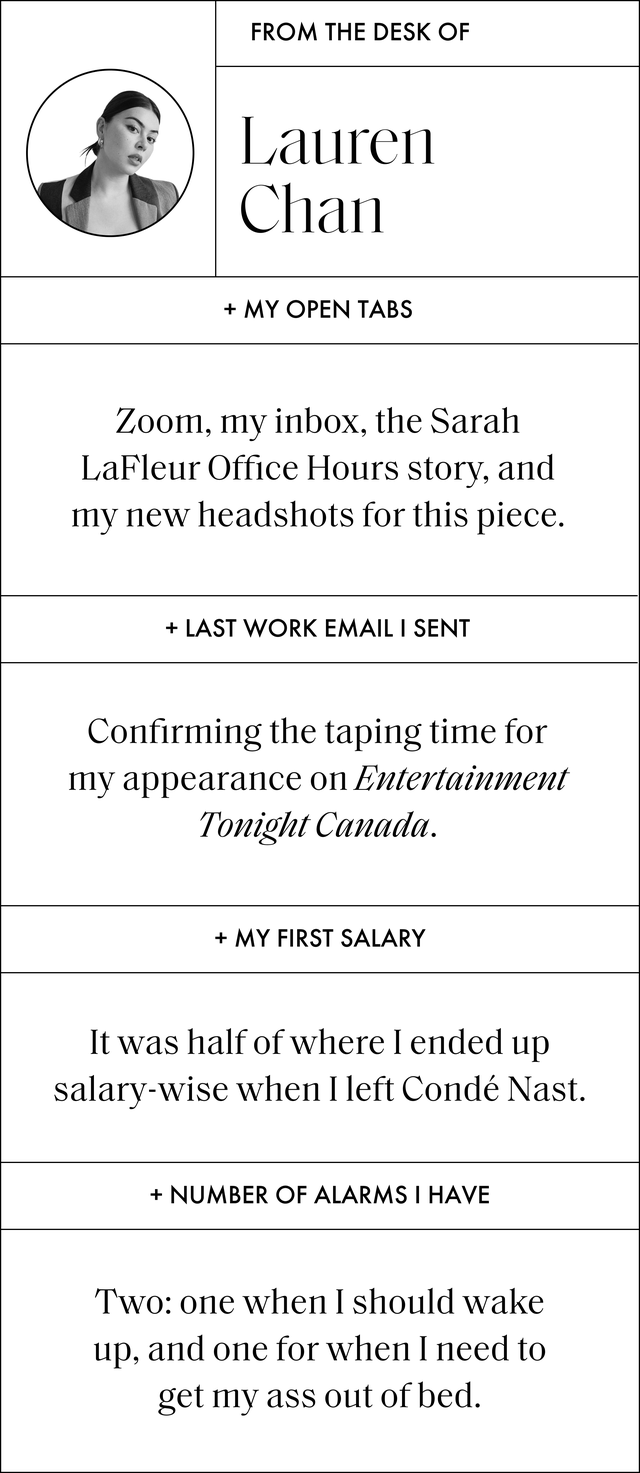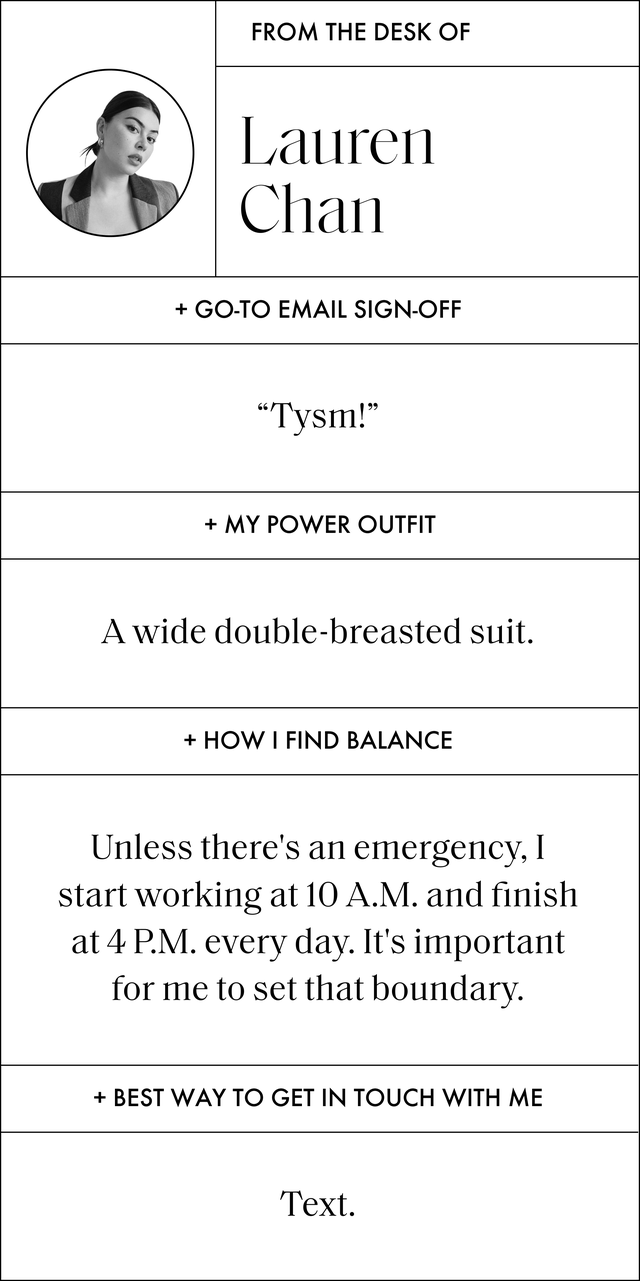Products You May Like
In ELLE.com’s monthly series Office Hours, we ask people in powerful positions to take us through their first jobs, worst jobs, and everything in between. This month we spoke candidly to model, former editor, and founder Lauren Chan, who, after facilitating the acquisition of her size-inclusive brand Henning to Universal Standard, recently made history as the first plus-size, queer model to earn the Rookie title in Sports Illustrated’s annual Swimsuit issue. “I feel tired, excited, relieved it all went well…all the things,” she tells ELLE.com of her new chapter, which came after announcing her divorce to her ex-husband earlier this year. “My longtime goal is to make sure whatever I’m working on in fashion ensures that women who have been marginalized by the industry due to their size or physical attributes feel equal, included, and powerful. Although my career is a little bit all over the place, that through line is very centering to me.” Here, Chan discusses why she decided to share her personal story, the importance of size inclusivity in fashion, and the hard lessons she’s learned along the way.
My first job
Fun fact: I was a counselor at a basketball camp in Muskoka, Canada. But my first office role was as an associate fashion writer at Glamour. My job was to write the small bits of copy in the magazine, whether that was the editorial captions or the 50- to 70-word news pieces on the front of book news pages, and I loved it. This was circa 2015, and I feel lucky to have caught the tail end of magazines as I had always admired them from the movies: the print issues, the culture, the editors. I got to see a glimpse of that before everything really took a sharp turn to digital. I worked for Jane Keltner de Valle, Wendy Naugle, and Cindi Leive, who were my fashion news director, deputy editor, and editor-in-chief, respectively. I can’t even put into words how lucky I feel to have worked for these women. They taught me how to be an editor, an outspoken professional, and connect with people, whether they’re readers or followers. I can still hear Cindi’s voice in my head whenever I write.
The hardest job I ever had
Probably my fashion internships, specifically in the fashion closet. I have been lost on the subways of New York City holding 40 pounds of clothing returns with my feet bleeding.
What I learned from being an editor
How to speak up. I had—and still have—an intense passion for size inclusivity. It was a topic that data proved would work, yet, at the time, there wasn’t anyone currently at the magazine to be the face of that. I had a print column and digital vertical within just of year of being at Glamour. They put me on Good Morning America and The Today Show, I hosted events and represented the brand at fashion week in New York and London, and, ultimately, I got to design clothing collections for our collaboration with Lane Bryant. Ultimately, that’s what led me to start Henning.
Why I launched Henning
When I left publishing, I originally wanted to work in fashion tech, where I could somehow convince other brands to increase their size range. I thought that was the best way to get more product options in the closets of plus-size women. But I quickly learned that I was not the right person for that job; I had never made clothes, and I had never worked in tech. Instead, I thought it would be a good idea to turn my small, public-facing career and little design experience I had to create my own brand. And when I thought of what that brand would look like, the answer was largely selfish: the pieces that I did not have access to and wanted so badly throughout my career as an editor. I knew from my lived experience that the clothing offered in the market was not enough. In terms of style, quality, et cetera, I knew that women like me were in high-powered jobs and needed clothing that was missing, and I believed in my voice, my taste level, and my passion.
The biggest lesson I learned as an entrepreneur
Do your research. I was working for myself, so I made ample time for meetings and consulting appointments, both online and on the ground, in-person. My editorial skill set of reporting, producing, managing, and running a section transferred so well to the early stages of building a company. I had never been to business school. I had never built a business. I had never had a corporate job outside of publishing. So, when I met with folks who worked in advertising, supply chain, and product development, I took their advice and collected it like it was a chart of data points. But then I realized that it was just data, and I had to find my own path forward.
How the Universal Standard opportunity came about
I feel like I manifested it. I’ve had a longstanding relationship with [Universal Standard co-founders] Polina Veksler and Alex Waldman, from first meeting them as a journalist to modeling for them and eventually hosting a Henning pop-up shop in their New York City showroom, and, as a customer, I’ve always been extremely impressed by what they’ve been able to do for this industry. They make clothes in sizes 00 to 40! It’s the most size-inclusive brand in the world. They went and did what the entire global industry said could not be done, and it’s the exact same sentiment that I had been yelling from the rooftops. [Henning] was a small independent business; I wasn’t able to get that level on my own. But I’m fucking excited to now be part of that.
Why I always push for more inclusivity in the plus-size space
We shouldn’t get discouraged by what we see on the runway, because, at the end of the day, roughly 70 percent of women in this country are plus-size. Those people still have to get dressed, and we still have to get them dressed. The path towards complete size inclusion will never be linear; there will be two steps forward and a step back. It’s about how we handle the step back. As an industry, we’re doing a good job of noticing and saying that we don’t stand with it.
Proudest career moment
I believe Henning is the first independent plus-size business to make a successful exit, and I am so proud of that, because nine out of 10 startups fail. It proves that plus-size fashion is, in fact, a viable business. We will shop at a higher price point, we have jobs that require well-made fashion garments, we are fashion fans, and we love ourselves enough to get dressed. As plus-size women, we are just as valuable as other women.
This interview has been edited and condensed.
Deputy Editor
Claire Stern is the Deputy Editor of ELLE.com. Previously, she served as Editor at Bergdorf Goodman. Her interests include fashion, food, travel, music, Peloton, and The Hills—not necessarily in that order. She used to have a Harriet the Spy notebook and isn’t ashamed to admit it.



